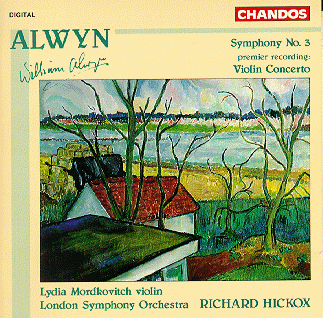THE WILLIAM ALWYN SOCIETY
President: Mary AlwynPatron: Vilem Tausky CBE


Cover Painting: Stubble Field by William Alwyn
Symphony No
3
Violin Concerto
Lydia Mordkovitch (violin)
The London Symphony Orchestra
conducted by Richard Hickox
Notes © by Mary Alwyn
Symphony No. 3 has quite a different approach from that of Alwyn's first two symphonies, with a new solution to the problems of modern harmony and melody by dividing the 12 semitones of the scale into two groups. The idea was suggested to him by the gamut of notes in Indian classical music.
 is important throughout the movement and is frequently reinforced with side drum,
tenor drum and xylophone.
is important throughout the movement and is frequently reinforced with side drum,
tenor drum and xylophone.It is a stormy and passionate work, strongly rhythmic in the outer movements but finding tranquillity and repose in the Adagio and in the closing pages of the symphony. The first performance was given at the opening concert of the 1956/57 BBC Symphony Orchestra Concerts at the Royal Festival Hall, London, under Sir Thomas Beecham.
Three years later there is a letter from Sir Henry wood - always the champion of the British composer - who had been looking for works for the next season's Proms. He thanks Alwyn for letting him see the new Violin Concerto: "I certainly hoped to give it a chance, but after three days consideration the BBC turned it down - so sorry."
So the Concerto was put away at the back of a cupboard to remain forgotten and unheard for 50 years until this very fine recording, which is in reality a first performance!
It is a work full of flowing tunes. In the first movement when these are taken up by the orchestra, the solo violin weaves a tracery of sound above. Although there are no formal cadenzas there are several passages marked quasi cadenza where the soloist is accompanied by a series of quiet orchestral chords. The ending is pianissimo - the initial melody is now played very simply, with the solo violin soaring ever more softly over the chords on the strings.
The second movement opens with muted strings, the soloist entering dolcissimo playing a longer version of the tune. This broadens to another quasi cadenza above simple, held chords on the strings. The atmosphere of quiet serenity increases until a mezzo forte orchestral entry introduces a new motif - a hint of an Irish folk tune, played by a solo viola. The soloist's delicate response to this brings the movement to a pianissimo close.
Brilliant virtuoso violin writing in the third movement uses the whole range of the instrument. After the soloists broad melody on the G string a rhythmic semiquaver is tossed about the orchestra, then taken up by the soloist, leading to a grazioso tune. Leaping arpeggios accompany the orchestra until changing to 3:4 time the movement quietens to pizzicato strings and glockenspiel. A sudden fanfare on the brass and a final flourish from the soloist brings the work to a fortissimo ending.
| Gramophone - January 1994 The Violin Concerto (so sympathetically played here by Lydia Mordkovitch), like the Piano Concerto No. 2, is little known. In 1940 it was first heard at a private performance. On that occasion Frederick Crinke was the soloist, with the composer playing the orchestral part on the piano. Sir Clifford Curzon, who was there to participate in some of Alwyn's chamber music at the same 'promotional' concert, thought highly of it and wrote to Alwyn to say so. But the work was refused a first performance at the Proms (Sir Henry Wood's enthusiasm was not shared by the BBC) and (the score) went into the cupboard. It is surely an ideal piece for a disc. Although essentially threnodic and lyrical. the first movement opens confidently and the orchestra returns with regular bursts of energy, and the end of the movement (the rapt pianissimo closing section) is exquisite. One is reminded here of the Vaughan Williams of The lark ascending, although as the second movement Allegretto opens, the melodic writing also brings hints of Elgar. Later the Vaughan Williams impression returns when a solo viola gently shares a duet with the soloist. The finale is fairly vigorous, but again the lyrical impulse is all important. The work is discursive, yet has moments of great intensity. The performance could not be bettered and Mordkovitch's pianissimo playing is touchingly beautiful. The Third Symphony is an outstanding example of Alwyn's earlier symphonic manner and a more immediately enjoyable work than the Fifth. John Ireland thought it "the finest British Symphony since the Elgar No. 2". It is in three movements. The first combines driving rhythmic agitation with a powerful lyrical thrust. The Adagio, introduced by a peaceful horn theme (bringing a distinct reminder of "Venus" from Holst's Planets), has an animated, brassy development, then ethereal strings restore the sense of repose, the horns returning glowingly (5'09"). After another angry disturbance, the movement ends ethereally with strings and cor anglais (a particularly beautiful moment here). The finale restores the forward momentum with its rhythmic zest and has a powerful and satisfying resolution (after another clear allusion to The Planets-this time to "Mars"). Hickox's reading is every bit as convincing as that of the composer on Lyrita and the LSO once more responds committedly to a work that must be rewarding to play when the orchestration is so effective. The Chandos recording gives much less cause for grumbles here concerning lack of definition, for the resonance suits both works largely because of their expansive character. Ivan March |
 Return
to Discography
Return
to Discography